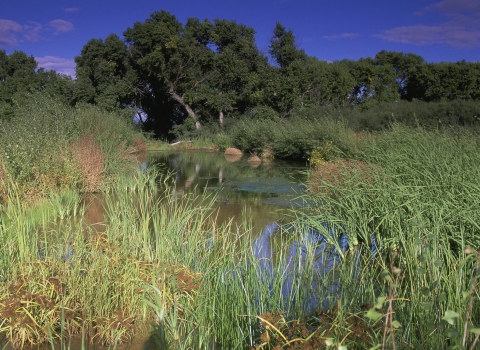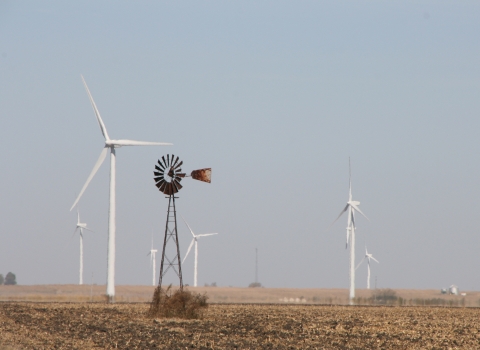Press Release
Secretary Kempthorne Announces Funding for Wetlands Projects, Additions to National Wildlife Refuges
At its June 14, 2006 meeting, the Migratory Bird Conservation Commission approved important additions to the National Wildlife Refuge System through the Migratory Bird Conservation Fund, as well as 54 conservation projects under the North American Wetlands Conservation Act's Standard and Small Grants Program to help conserve migratory bird populations and habitats.
"Few conservation programs approach the efficiency of the North American Wetlands Conservation Act," said Dirk Kempthorne, Secretary of the Interior and Chair of the Commission. "From the acquisition of wetland habitat for waterfowl and for public enjoyment on our national wildlife refuges and other public lands, to habitat enhancements done on private lands, the Commission oversees one of the great wetland and waterfowl conservation programs of our Nation.
"The Commission approved more than $1.3 million to acquire 291 acres of wetlands and associated upland habitats for the National Wildlife Refuge System in Oregon, Virginia, North Carolina, New Jersey, and California. Funding for these acquisitions comes primarily from the purchase of Federal Duck Stamps by hunters and other conservationists.
New National Wildlife Refuge System acquisitions and easements, all previously approved by the respective states, include:
California: Acquisition of 59 acres in the North Central Valley Wildlife Management Area across 11 counties to protect, restore and maintain wetlands for waterfowl and other migratory bird populations.
California: Purchase of a perpetual easement on 78 acres in the Grassland Wildlife Management Area across in Merced County to protect and enhance critical wetland and waterfowl habitats, and provide important wintering habitats for migratory waterfowl.
North Carolina: Acquisition of 14 acres at the Cedar National Wildlife Refuge to preserve habitat for wintering migratory waterfowl.
New Jersey: Acquisition of 35.2 acres at Edwin B. Forsythe National Wildlife Refuge to preserve and enhance lands and waters to conserve the natural diversity of fish, wildlife, and plants including black ducks and other waterfowl.
Oregon: Acquisition of 36 acres for Willliam L. Finley National Wildlife Refuge to protect, restore and enhance a diversity of Willamette Valley flood plain habitats for waterfowl and indigenous species.
Virginia: Acquisition of 146.7 acres to protect and manage migration, breeding and wintering habitat for waterfowl at the Eastern Shore of Virginia National Wildlife Refuge.
Refuge land acquisitions are funded by Duck Stamp sales and from import duties collected on arms and ammunition, right-of-way payments to the refuge system and receipts from National Wildlife Refuge entrance fees. Since its inception in 1934, the Federal duck stamp program has generated more than $700 million. That has been used to acquire more than 5.2 million acres for the refuge system.
The Commission also approved more than $17.8 million to fund seven wetland-habitat conservation projects in Canada under the North American Wetlands Conservation Act's Standard Grants Program, based on recommendations made by the North American Wetlands Conservation Council. Canadian partners are contributing $24.5 million towards these projects, which will conserve more than 87,000 acres of migratory bird habitat. For brief project descriptions, visit http://www.wetlandscanada.org/june%202006%20projects.html
In addition, the Council reported to the Commission the 47 U.S. projects that were selected to receive the $2 million in funding that the Commission had approved last June for the North American Wetlands Conservation Act's Small Grants Program for FY 2006. Partnerships in 25 states will contribute an additional $16.8 million to these projects to help conserve more than 25,500 acres of wetland habitats for the benefit of migratory birds. Brief project descriptions can be found at http://www.fws.gov/birdhabitat/Grants/NAWCA/Small/2006.shtm
To date, more than 3,150 partners have been involved in 1,556 wetlands conservation projects under the Act's Standard and Small Grants Programs combined. Projects in the United States, Canada, and Mexico focus on long-term protection, restoration, or enhancement of important wetland habitats. In Mexico, partners may also develop training, management, and environmental education programs and conduct studies on sustainable use. In total, more than $742 million in Act grants have been invested in the three countries, and partner contributions have topped $2.1 billion. Approximately 23 million acres of wetlands and associated uplands have been conserved under the Act. For general information about the Act, visit http://www.fws.gov/birdhabitat/Grants/NAWCA/index.shtm.
The Cabinet-level Commission, which has final funding authority for National Wildlife Refuge System additions and for North American Wetlands Conservation Act grants, is comprised of Secretary Kempthorne, Senators Thad Cochran of Mississippi and Blanche Lincoln of Arkansas, Representatives John Dingell of Michigan and Curt Weldon of Pennsylvania, Secretary of Agriculture Mike Johanns, and Environmental Protection Agency Administrator Stephen L. Johnson.
"Few conservation programs approach the efficiency of the North American Wetlands Conservation Act," said Dirk Kempthorne, Secretary of the Interior and Chair of the Commission. "From the acquisition of wetland habitat for waterfowl and for public enjoyment on our national wildlife refuges and other public lands, to habitat enhancements done on private lands, the Commission oversees one of the great wetland and waterfowl conservation programs of our Nation.
"The Commission approved more than $1.3 million to acquire 291 acres of wetlands and associated upland habitats for the National Wildlife Refuge System in Oregon, Virginia, North Carolina, New Jersey, and California. Funding for these acquisitions comes primarily from the purchase of Federal Duck Stamps by hunters and other conservationists.
New National Wildlife Refuge System acquisitions and easements, all previously approved by the respective states, include:
California: Acquisition of 59 acres in the North Central Valley Wildlife Management Area across 11 counties to protect, restore and maintain wetlands for waterfowl and other migratory bird populations.
California: Purchase of a perpetual easement on 78 acres in the Grassland Wildlife Management Area across in Merced County to protect and enhance critical wetland and waterfowl habitats, and provide important wintering habitats for migratory waterfowl.
North Carolina: Acquisition of 14 acres at the Cedar National Wildlife Refuge to preserve habitat for wintering migratory waterfowl.
New Jersey: Acquisition of 35.2 acres at Edwin B. Forsythe National Wildlife Refuge to preserve and enhance lands and waters to conserve the natural diversity of fish, wildlife, and plants including black ducks and other waterfowl.
Oregon: Acquisition of 36 acres for Willliam L. Finley National Wildlife Refuge to protect, restore and enhance a diversity of Willamette Valley flood plain habitats for waterfowl and indigenous species.
Virginia: Acquisition of 146.7 acres to protect and manage migration, breeding and wintering habitat for waterfowl at the Eastern Shore of Virginia National Wildlife Refuge.
Refuge land acquisitions are funded by Duck Stamp sales and from import duties collected on arms and ammunition, right-of-way payments to the refuge system and receipts from National Wildlife Refuge entrance fees. Since its inception in 1934, the Federal duck stamp program has generated more than $700 million. That has been used to acquire more than 5.2 million acres for the refuge system.
The Commission also approved more than $17.8 million to fund seven wetland-habitat conservation projects in Canada under the North American Wetlands Conservation Act's Standard Grants Program, based on recommendations made by the North American Wetlands Conservation Council. Canadian partners are contributing $24.5 million towards these projects, which will conserve more than 87,000 acres of migratory bird habitat. For brief project descriptions, visit http://www.wetlandscanada.org/june%202006%20projects.html
In addition, the Council reported to the Commission the 47 U.S. projects that were selected to receive the $2 million in funding that the Commission had approved last June for the North American Wetlands Conservation Act's Small Grants Program for FY 2006. Partnerships in 25 states will contribute an additional $16.8 million to these projects to help conserve more than 25,500 acres of wetland habitats for the benefit of migratory birds. Brief project descriptions can be found at http://www.fws.gov/birdhabitat/Grants/NAWCA/Small/2006.shtm
To date, more than 3,150 partners have been involved in 1,556 wetlands conservation projects under the Act's Standard and Small Grants Programs combined. Projects in the United States, Canada, and Mexico focus on long-term protection, restoration, or enhancement of important wetland habitats. In Mexico, partners may also develop training, management, and environmental education programs and conduct studies on sustainable use. In total, more than $742 million in Act grants have been invested in the three countries, and partner contributions have topped $2.1 billion. Approximately 23 million acres of wetlands and associated uplands have been conserved under the Act. For general information about the Act, visit http://www.fws.gov/birdhabitat/Grants/NAWCA/index.shtm.
The Cabinet-level Commission, which has final funding authority for National Wildlife Refuge System additions and for North American Wetlands Conservation Act grants, is comprised of Secretary Kempthorne, Senators Thad Cochran of Mississippi and Blanche Lincoln of Arkansas, Representatives John Dingell of Michigan and Curt Weldon of Pennsylvania, Secretary of Agriculture Mike Johanns, and Environmental Protection Agency Administrator Stephen L. Johnson.

